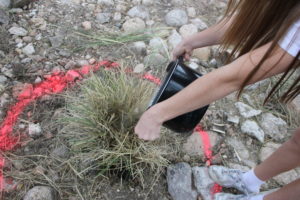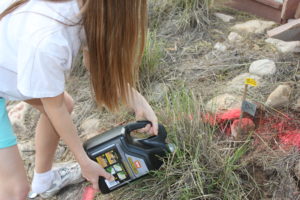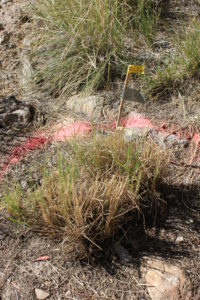
Applying Various Treatments to the Grass
One may notice on my website that much of my work in the field of natural resources has actually been associated with botany, or plants. Obviously, this may raise the question of why this is all present on a website that technically should be dedicated to wildlife. Nonetheless, having a strong background in botany is important in the field of wildlife conservation, given that plants are at the bottom of the food chain and thus affect species at higher trophic levels. There is never any harm in studying these organisms at a continuously deeper level.

Pulling the Grass by Hand
One of my first research projects related to this field involved buffel grass (Cenchrus ciliaris), an invasive species here in Arizona. I applied various treatments to the organism in order to study what most effectively kills it; the experiment itself was conducted when I was in 8th grade in January and February of 2012 (as a side note, that was also the year I got my first motion-activated camera trap, but to see where that research went, check out my post, “No Room In Avilla (SARSEF 2016)” ;). The work was done within a small wash that runs by my house, given that the area is completely overgrown with the invader. Seven different treatments were applied; three were weedkillers (RoundUp, Spectracide Weed and Grass Killer Concentrate, and Ortho GroundClear Vegetation Killer) while another three were homemade remedies that I had discovered by doing some online research (pool salt, distilled white vinegar (5% acidity), and boiling water). The last idea was simply to pull the grass by hand. I then recorded my observations and any visible changes in the organisms within a notebook for the following three weeks (once a week), as well as took pictures every time I went back out to inspect.

Presenting the Various Treatments Used
One patch of buffel grass was chosen for each treatment; care was taken to ensure that they were of approximately the same size. Orange spray paint was then utilized to draw a circle ~3 feet in diameter around each treated plant. Additionally, a long stick with a duct tape “flag” attached was set in the ground within each circle naming the treatment that was used on that particular spot and displaying a “do not disturb” notice. Finally, a weed wacker was employed to cut off the top of each grass patch until they reached one to two feet above the ground.

Preparing Labels
Each treatment was applied differently. Pulling the grass involved digging up all the roots, while the three herbicides each had different instructions for use. RoundUp was prepared through adding six fluid ounces to one gallon of water, while Spectracide involved combining one quart of the weedkiller with one gallon of water. Ortho did not require any mixing; it was simply poured until the ground was thoroughly wet. As for the homemade remedies, salt was sprinkled over the area (one cup) and then dissolved with water, while the entire bottle of vinegar was dumped out (32 ounces). The final plant was treated with two gallons of boiling water. Nonetheless, despite all these various methods, one common trend for every remedy was to apply it to the entire region within the marked circle, though primarily at the base of the grass. In conclusion, my hypotheses were that pulling by hand and applying Ortho GroundClear Vegetation Killer would be the most effective in killing the plant, while boiling water would show no results.


Applying the Salt and Boiling Water Treatments

Applying the Ortho Herbicide
The results indicated that pulling by hand was the most effective treatment; the grass never regrew over the course of the next three weeks. Boiling water had the second best outcome; the patch turned brown with green grass blades left only around the exterior of the plant. Vinegar had a similar effect; even the remaining green blades looked wilted while the middle of the patch was particularly gray. Ortho resulted in half the plant being gray, the salt and Spectracide caused their grasses to gray only at the center, and RoundUp was the least effective remedy. See the table below for more detail.
| Treatment: | Day of Treatment: | 1 Week After: | 2 Weeks After: | 3 Weeks After: |
| Hand-Pulled: 5 | The grass was pulled with some difficulty because of the tightly-anchored roots, but was nonetheless completely removed | There is no new visible growth | There is no new visible growth | There is no new visible growth |
| Boiling Water: 4 | Already partially brown with some green in the center and outer edges | The patch has browned in the center, leaving only green grass blades on the exterior | The patch is almost dead; only a few green grass blades stick out on the very edges of the plant | The patch is completely brown; only two or three green grass blades remain |
| Vinegar: 4 | Already partially brown with some green in the center and outer edges | Started browning at the very center of the plant, but not much | Most of the plant has turned to a brown-gray color; there’s still some green along the exterior | The grass is gray in the middle; even the remaining green grass blades on the edges look wilted |
| Ortho: 3 | Already partially brown with some green in the center and outer edges | The green grass coming out between the patch has started to take on a slight gray color | No further results | Half the plant is gray while the other half is a mixture of green and brown |
| Salt: 2 | Already partially brown with some green in the center and outer edges | Started browning at the very base of the plant, but not much | No further results | Only grayed at the center and base of the plant |
| Spectracide: 2 | Already partially brown with some green in the center and outer edges | Started browning at the very base of the plant, but not much | No further results | Only grayed at the center and base of the plant |
| RoundUp: 2 | Already partially brown with some green in the center and outer edges | Started browning at the very base of the plant, but not much | No further results | Only a tiny bit of brown and gray visible at the center and base of the grass |
Key:
1: Didn’t work at all
2: Only caused some gray and brown, but almost all of it is still green
3: About half the plant is gray and brown, but the green remaining still looks healthy
4: Almost the entire plant is dead; only some green is left
5: The entire plant is dead


Hand-Pulled Result Before Treatment and Three Weeks Later


Boiling Water Result Before Treatment and Three Weeks Later


Vinegar Result Before Treatment and Three Weeks Later


Ortho Result Before Treatment and Three Weeks Later


Salt Result Before Treatment and Three Weeks Later


Spectracide Result Before Treatment and Three Weeks Later


RoundUp Result Before Treatment and Three Weeks Later
Based off of my results, my hypothesis that hand-pulling would be the most effective was true, while the one that boiling water would be unsuccessful was incorrect given that it was among the best treatments. Additionally, my hypothesis that Ortho GroundClear Vegetation Killer would be among the better remedies was partially correct as it happened to land right in the middle of the best and worst ones. Nonetheless, if I were to redo this experiment, I would definitely apply the treatments to more than one patch of buffel grass over a longer period of time to see if these results hold up when used on plants growing in different kinds of soils and various weather conditions. Further, it would have been interesting to pull the test subjects at the end of the three weeks to document how easily the roots came out. This is especially important given that once the grass is dead, it still remains anchored in the ground and may eventually disperse any remaining seeds. Another thought that comes to mind upon looking at this project five years later is how to determine if the organism is actually “dead;” the species naturally looks brown at certain times of the year. For my experiment, I had chosen patches that showed green blades and then largely drew my conclusions based off of how little green was left/how much the grass grayed. Finally, there is the ever-present question of what harm the applied treatments could have on native plants. Even if there had been a remedy that was just as effective as hand-pulling, would it have been a wise choice to use all around the state? Such research on something that would only harm particular invaders but not native species would be an interesting endeavor for perhaps a graduate student to tackle.
As one last comment, and hence the title of this post, my project took me to the Southern Arizona Research, Science, and Engineering Fair (SARSEF) in March. There I received third place in Earth Sciences at the middle school level, as well as an honorable mention from the School of Plant Sciences at the University of Arizona. Below are some pictures of me being interviewed by the judges.








wow
we are looking your website
wonderful
by by Ariel Sofia Ian Carlo Monica
Haha, grazie!